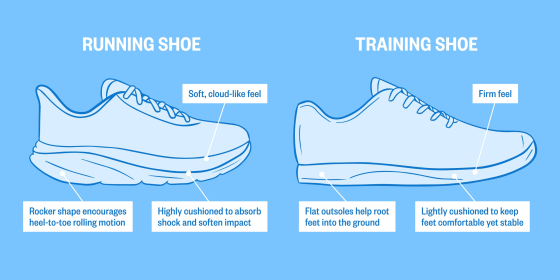When it comes to fitness, the right footwear can make a world of difference. Whether you are lifting weights or hitting the pavement for a jog, choosing the right shoes plays a crucial role in optimizing performance, preventing injuries, and enhancing overall comfort. In this guide, we’ll explore the best shoes for both lifting and running, compare various options, and provide tips to help you make an informed decision.
Why Choosing the Right Shoe Matters
The importance of selecting suitable footwear cannot be overstated. A good pair of shoes can help you:
- Enhance performance during workouts.
- Prevent injuries such as plantar fasciitis or ankle sprains.
- Maximize comfort and reduce fatigue.
- Provide the necessary support based on your activity.
Key Differences Between Lifting Shoes and Running Shoes
Design and Structure
Lifting shoes typically have a raised heel to aid in squat depth and stability, while running shoes offer cushioning and flexibility for impact absorption. Understanding these differences is essential when selecting footwear for your specific needs.
Material and Weight
Lifting shoes are often made from leather or synthetic materials that provide support, while running shoes utilize lightweight mesh for breathability. The material impacts how the shoe performs during different activities.
Best Shoes for Lifting
Top Lifting Shoes of 2023
| Brand | Model | Heel Height | Weight | Price | Pros | Cons |
|---|---|---|---|---|---|---|
| Nike | Romaleos 4 | 20mm | 14.4 oz | $199 | Stability, Durability | Pricey |
| Adidas | Adipower Weightlifting II | 15mm | 12.6 oz | $179 | Comfort, Flexibility | Less breathable |
| Reebok | Legacy Lifter II | 20mm | 14 oz | $159 | Support, Style | Heavy |
| Inov-8 | Fastlift 360 | 20mm | 10.6 oz | $179 | Versatile, Lightweight | Narrow fit |
Pros and Cons of Lifting Shoes
Pros
- Improved lifting form and stability.
- Dedicated support for weightlifting movements.
- Enhanced strength during squats and deadlifts.
Cons
- Not suitable for running or cardio.
- Typically heavier compared to running shoes.

Best Shoes for Running
Top Running Shoes of 2023
| Brand | Model | Cushioning Type | Weight | Price | Pros | Cons |
|---|---|---|---|---|---|---|
| Asics | Gel-Kayano 30 | Gel cushioning | 10.9 oz | $160 | Stability, Comfort | Heavy for some |
| Brooks | Ghost 15 | BioMoGo DNA | 10.1 oz | $140 | Versatile, Soft cushioning | Not for overpronators |
| Nike | Air Zoom Pegasus 39 | React foam | 9.6 oz | $130 | Lightweight, Responsive | Durability concerns |
| Hoka One One | Clifton 9 | Compression EVA | 10.4 oz | $140 | Comfort, Excellent cushioning | Bulkier than some prefer |
Pros and Cons of Running Shoes
Pros
- Optimized for forward motion and impact absorption.
- Variety of options for different foot types and running styles.
- Breathable materials keep feet cool.

Cons
- Not suitable for heavy lifting.
- Cushioning may reduce stability for weight training.
Cross-Training Shoes: A Versatile Option
If you engage in both lifting and running, cross-training shoes might be the most versatile choice. Here, we highlight a few popular cross-training shoes:
| Brand | Model | Primary Use | Weight | Price | Pros | Cons |
|---|---|---|---|---|---|---|
| Reebok | Nano X2 | CrossFit, Running | 10.4 oz | $140 | Flexible, Supportive | Not specialized |
| Nike | Metcon 8 | Weightlifting, HIIT | 11.6 oz | $150 | Stability, Multi-purpose | Heavier than running shoes |

Choosing the Right Shoe: Tips and Considerations
Know Your Feet
Understanding your foot type is crucial. You can opt for a gait analysis at local running stores to determine your arch type and pronation.
Consider Your Training Routine
Your training regimen should dictate your footwear choice. If you visit the gym primarily for weightlifting, invest in lifting shoes. Alternatively, focus on running shoes if your routine involves more cardio.

Test Before You Buy
Always try shoes on and walk or jog around the store to check comfort. Pay attention to how they fit and adjust during movement.
Check Reviews and Ratings
Consumer reviews provide insight into the performance and durability of shoes. Websites like Runner’s World offer comprehensive shoe reviews.

Frequently Asked Questions (FAQs)
1. Can I use running shoes for lifting?
While it’s possible, running shoes typically provide less support and stability compared to lifting shoes, which could compromise your form during weightlifting.
2. Are cross-training shoes good for running?
Cross-training shoes can be suitable for running, especially for shorter distances, but they might not provide the level of cushioning and support that dedicated running shoes offer.

3. How often should I replace my running/lifting shoes?
Running shoes should generally be replaced every 300 to 500 miles, while lifting shoes can last longer, often ranging from 1 to 3 years depending on usage.
4. What is the ideal heel height for lifting shoes?
The ideal heel height varies per individual, but a range of 0.5 to 1 inch is commonly recommended for improved squat depth and stability.

Conclusion
Selecting the best shoes for lifting and running is crucial for achieving your fitness goals. With numerous brands and models available, it’s essential to consider your activity level, foot type, and personal preferences. From specialized lifting shoes providing stability to comfortable running shoes designed for impact absorption, the right fit can make all the difference in your workout experience. Always stay informed about advancements and options available in the market to ensure you choose the best footwear for your fitness journey.
For further reading on shoe technology and innovation, explore the National Institutes of Health’s research on footwear design. Staying educated on the evolving landscape of athletic shoes helps you make informed decisions for your health and performance.